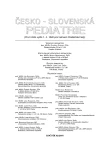Unstable Hemoglobin Variants in Children of the Czech and Slovak Population
Authors:
D. Pospíšilová 1; V. Divoký 2,5; J. Čermák 3; L. Chrobák 4; K. Indrák 5
Authors‘ workplace:
Dětská klinika Lékařské fakulty Univerzity Palackého a Fakultní nemocnice, Olomouc
přednosta prof. MUDr. V. Mihál, CSc.
1; Ústav biologie Lékařské fakulty Univerzity Palackého, Olomouc
přednosta doc. RNDr. V. Divoký, Ph. D.
2; Ústav hematologie a krevní transfuze, Praha
ředitel prof. MUDr. P. Klener, DrSc.
3; Oddělení klinické hematologie LF UK a FN, Hradec Králové
přednosta prof. MUDr. J. Malý, CSc.
4; Hemato-onkologická klinika Lékařské fakulty Univerzity Palackého a Fakultní nemocnice, Olomouc
přednosta prof. MUDr. K. Indrák, DrSc.
5
Published in:
Čes-slov Pediat 2007; 62 (9): 519-526.
Category:
Original Papers
Overview
Introduction:
Unstable hemoglobinopathies are caused by mutations of globin genes. Amino acid substitutions of globin chains in the region of heme pocket lead to alterations of its hydrophobic properties with various degree of ferroheme oxidation and methemoglobinemia. Precipitation of unstable hemoglobin in erythrocytes associated with the formation of inclusion bodies affects plasticity of erythrocyte membrane and results in deterioration of their passage through microcirculation and premature destruction, especially in the spleen.
Patients and results:
In the Czech and Slovak population, 8 types of unstable hemoglobins have been described in 9 children. Two mutations were identified for the first time (Hb Haná, Hb Hradec Králové), mutations in the other children had been described before (Hb Köln, HbE, Hb Nottingham, Hb Sydney, Hb Saint Louis, Hb Santa Ana). Clinical and laboratory findings were variable, and intensity of hemolysis was dependent on the stability of globin chains or other modifying genetic factors. The most severe hemolytic anemia was present in a child with Hb Nottingham and in a female patient with HbE, however, in this patient the severity of anemia was influenced by two other globin gene defects. Manifestations of hemolysis in the other children were of mild degree with typical deterioration after oxidative drugs and infections.
Conclusions:
Changes in blood count and biochemical indices of hemolysis are not specific for unstable hemoglobinopathies. Diagnosis may be established by using tests of stability, electrophoretic analysis of hemoglobin lysate and sequence analysis of globin genes at the DNA level. In case of hyperunstable hemoglobinopathies, the molecular genetic analysis is necessary. The long term interval between the first signs of the disease and establishment of correct diagnosis indicates the diagnostic complexity of these rare hematological disorders.
Key words:
hemolysis, hemoglobinopathy, unstable hemoglobin, Heinz bodies, tests of hemoglobin stability, DNA sequencing, Hb Köln, Hb St. Louis, Hb Nottingham, HbE, Hb Hradec Králové, Hb Haná, Hb Sydney, Hb Santa Ana
Labels
Neonatology Paediatrics General practitioner for children and adolescentsArticle was published in
Czech-Slovak Pediatrics

2007 Issue 9
Most read in this issue
- Infection with Bacteria Pseudomonas aeruginosa in Patients with Cystic Fibrosis Diagnostics Possibilities and Clinical Outcomes of a Three-Year Study
- Disorders of Hemostasis in Newborns
- Unstable Hemoglobin Variants in Children of the Czech and Slovak Population
- Program of Hematopoietic Stem Cell Transplantation in Children at Department of Pediatric Hematology and Oncology, University Hospital Motol – from Fetal Liver to Cord Blood
